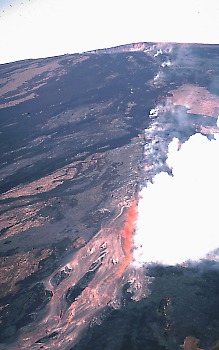
|
|
Volcanic Hazards |
"It is profoundly significant that the Hawaiians of
Ka`u did not fear or cringe before, or hate, the power and
destructive violence of Mauna Loa. They took unto them this
huge mountain as their mother, and measured their personal
dignity and powers in terms of its majesty and drama."
Pukui and Handy, 1952
Historical Eruptions Spotlight
Potential Lava-Flow Inundation Areas
Thirty-three eruptions of Mauna Loa since 1843 have produced
lava flows covering 806 km2 (310 mi2) of the
Island of Hawai`i. Five eruptions generated lava flows that reached
the west coast of Hawai`i and one flow poured into the sea from
the southwest rift zone 15 km away in less than 3 hours! On the
northeast side of the volcano, land now within the city limits of
Hilo was covered by lava in 1880-81, and in 1984 a lava flow reached
to within 6.5 km (4 mi) of the outskirts of the city.
Since 1984, more than $2.3 billion have been invested in new construction on the slopes of Mauna Loa, and the amount increases daily. But it is well to remember that Mauna Loa will certainly erupt again, most likely within a few years to a few decades. Areas covered by the volcano's historical lava flows are clear reminders of the general pathways that the next lava may travel--that is, down nearly any side of the volcano depending on the where the next eruption occurs.
The Next Eruption: Where Will the Lava Flow?
Based on Mauna Loa's historical eruptions and detailed geologic maps of the volcano's surface, we have identified relative lava-flow hazard zones on the volcano and throughout the island of Hawai`i. Six zones were recognized on Mauna Loa. Until the next eruption begins, however, we cannot determine with certainty which areas will be inundated by lava during the next eruption.
The high rate of eruption typical of Mauna Loa, combined with the volcano's steep slopes, means that flows can move far and fast. Hence our monitoring efforts to identify areas threatened by lava in the first few hours of the next eruption assume great importance.
Lava-Flow Directions Depend on Four Key Factors
The actual areas that will be covered by lava flows, and the warning time that can be given before lava reaches a specific area, depend on several key factors that only become apparent when an eruption begins:- location of the erupting vent(s)
- rate of lava production
- duration of the eruption (see history table)
- local topography, especially steepness of ground
Summary of historical eruptions
References:
Trusdell, F., A., 1995, Lava flow hazards and risk assessment on Mauna Loa Volcano, Hawai`i, in Rhodes, J.M., and Lockwood, J. P. (eds.), Mauna Loa revealed: structure, composition, history, and hazards: Washington D.C., American Geophysical Union Monograph 92, p. 327-336.Pukui, K., and Handy J., 1952, The Polynesian family system in
Ka`u, Hawai`i, Bishop Museum Press, Honolulu, 300 p.
![]()
Contact: hvowebmaster@usgs.gov
Updated: 18 June, 2001 (pnf)

 Activity
Activity

